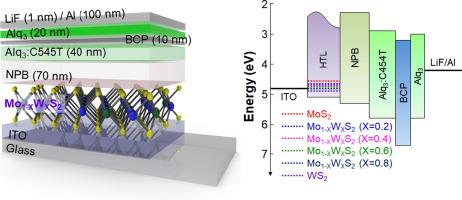当前位置:
X-MOL 学术
›
Appl. Surf. Sci.
›
论文详情
Our official English website, www.x-mol.net, welcomes your
feedback! (Note: you will need to create a separate account there.)
Synthesis of Atomically Thin Alloyed Molybdenum-Tungsten Disulfides Thin Films as Hole Transport Layers in Organic Light-Emitting Diodes
Applied Surface Science ( IF 6.3 ) Pub Date : 2021-03-01 , DOI: 10.1016/j.apsusc.2020.148529 Ki Chang Kwon , Tae Hyung Lee , Seokhoon Choi , Kyoung Soon Choi , Seung O. Gim , Sa-Rang Bae , Jong-Lam Lee , Ho Won Jang , Soo Young Kim
Applied Surface Science ( IF 6.3 ) Pub Date : 2021-03-01 , DOI: 10.1016/j.apsusc.2020.148529 Ki Chang Kwon , Tae Hyung Lee , Seokhoon Choi , Kyoung Soon Choi , Seung O. Gim , Sa-Rang Bae , Jong-Lam Lee , Ho Won Jang , Soo Young Kim

|
Abstract Two-dimensional transition metal dichalcogenides (TMDs) have been intensively researched due to their excellent physical, chemical, and mechanical properties, which make them essential for various electronic devices owing to several disadvantages of conventional hole-transport layers (HTLs) such as hygroscopic effect and highly acidic nature, which can induce low stability of the fabricated devices. Especially, they have been considered as hole-transport layers (HTLs) in organic light-emitting diodes (OLEDs) and organic photovoltaics due to its chemical stability. Despite of its adequate work-function value and chemical stability, the device stability could be enhanced but, device performance of pristine TMD-HTL-based has been reported lower than conventional devices. In this work, we report a facile route to synthesize alloyed transition metal disulfides (TMD) thin films and their application as hole transport layers in OLEDs. Polycrystalline, large-area, and uniform Mo1-XWXS2 thin films are synthesized via simple thermal disproportionation methods by chemical vapour deposition. The physical and chemical properties of the synthesized alloyed TMD layers are controlled by varying the precursor concentrations. The device performance of alloyed TMD-layer-based OLED is comparable to that of conventional poly(3,4-ethylenedioxythiophene):poly-(styrenesulfonate) (PEDOT:PSS) and device stability in air is significantly improved. Thus, a novel approach to synthesize alloyed Mo1-XWXS2 thin films and their application in optoelectronic devices are presented herein.
中文翻译:

作为有机发光二极管空穴传输层的原子级薄合金化钼-钨二硫化物薄膜的合成
摘要 二维过渡金属二硫属化物 (TMD) 由于其优异的物理、化学和机械性能而受到广泛研究,由于传统空穴传输层 (HTL) 的几个缺点,例如吸湿效应和高酸性性质,这会导致制造的器件稳定性低。特别是,由于其化学稳定性,它们被认为是有机发光二极管 (OLED) 和有机光伏器件中的空穴传输层 (HTL)。尽管其具有足够的功函数值和化学稳定性,但可以提高器件的稳定性,但据报道,基于原始 TMD-HTL 的器件性能低于传统器件。在这项工作中,我们报告了合成合金化过渡金属二硫化物 (TMD) 薄膜的简便途径及其作为 OLED 中空穴传输层的应用。多晶、大面积、均匀的 Mo1-XWXS2 薄膜是通过化学气相沉积通过简单的热歧化方法合成的。通过改变前体浓度来控制合成合金化 TMD 层的物理和化学性质。基于合金化 TMD 层的 OLED 的器件性能可与传统的聚(3,4-亚乙基二氧噻吩):聚(苯乙烯磺酸盐)(PEDOT:PSS)相媲美,并且器件在空气中的稳定性得到显着提高。因此,本文提出了一种合成 Mo1-XWXS2 合金薄膜的新方法及其在光电器件中的应用。
更新日期:2021-03-01
中文翻译:

作为有机发光二极管空穴传输层的原子级薄合金化钼-钨二硫化物薄膜的合成
摘要 二维过渡金属二硫属化物 (TMD) 由于其优异的物理、化学和机械性能而受到广泛研究,由于传统空穴传输层 (HTL) 的几个缺点,例如吸湿效应和高酸性性质,这会导致制造的器件稳定性低。特别是,由于其化学稳定性,它们被认为是有机发光二极管 (OLED) 和有机光伏器件中的空穴传输层 (HTL)。尽管其具有足够的功函数值和化学稳定性,但可以提高器件的稳定性,但据报道,基于原始 TMD-HTL 的器件性能低于传统器件。在这项工作中,我们报告了合成合金化过渡金属二硫化物 (TMD) 薄膜的简便途径及其作为 OLED 中空穴传输层的应用。多晶、大面积、均匀的 Mo1-XWXS2 薄膜是通过化学气相沉积通过简单的热歧化方法合成的。通过改变前体浓度来控制合成合金化 TMD 层的物理和化学性质。基于合金化 TMD 层的 OLED 的器件性能可与传统的聚(3,4-亚乙基二氧噻吩):聚(苯乙烯磺酸盐)(PEDOT:PSS)相媲美,并且器件在空气中的稳定性得到显着提高。因此,本文提出了一种合成 Mo1-XWXS2 合金薄膜的新方法及其在光电器件中的应用。











































 京公网安备 11010802027423号
京公网安备 11010802027423号